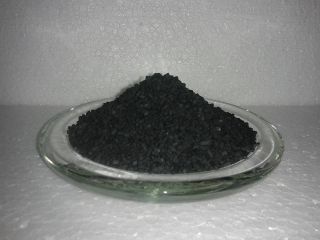Activated carbon
 |
This article is a stub. Please help Sciencemadness Wiki by expanding it, adding pictures, and improving existing text.
|
Activated carbon or activated charcoal, activated coal or simply active carbon a form of carbon or charcoal processed to have small, low-volume pores, to increase the surface area available for adsorption or chemical reactions.
Generally, the main difference between normal charcoal and activated charcoal is that the latter has its microstructure specially engineered for maximum specific surface and high adsorbtion. Sometimes further chemical treatment is used to enhances adsorption properties.
Contents
Types
The most common forms of activated carbon encountered are powder and pellets. The pellet form has the advantage of better mechanical stability and as such is commonly used in various filters.
Properties
Activated carbon is a black solid with a grayish luster, with a very high specific surface (500-5000 m2/g). Its high specific surface allows it to adsorb various gasses and liquids, as well as small size particles, a property widely exploited in water purification. While it's generally encountered as a powder, activated charcoal is also available as pellets or beads. It is insoluble in all solvents and will burn in air if ignited, though it does not ignite very easy.
Activated charcoal is sometimes used as a catalyst in various chemical reactions.
Availability
Powdered activated charcoal is sold in various pharmacies. It can also be bought from a vet or from pet shops.
Gas mask filters tend to contain activated carbon in pellet form.
Some old hard drives also contain activated charcoal as either beads or powder, in a small plastic vial, glued inside.
Preparation
Activated charcoal can be made from common charcoal or sugar charcoal (made by dehydrating sugar with concentrated sulfuric acid), by treating it with superheated steam (some sources say 800-900 °C) or with hot phosphoric acid. Boiling charcoal in water will also activate it, although this type of activated charcoal, while better than untreated charcoal, is still inferior to the OTC type.
However, activating the charcoal at home is generally not worth the effort and it's much cheaper to simply just purchase it from the store.
Projects
- Water purification
- Clean various liquids from small particles
- Make a gas mask
- Make an air purification system
- Absorb toxic spills
- Remove unpleasant smell from room
Handling
Safety
Activated charcoal is considered safe and it's also approved for medical use. Finely powdered activated charcoal may form explosive mixtures with air in confined places.
Storage
Activated carbon should be stored in closed bottles, to prevent it from adsorbing various gasses and liquids from air. Try to avoid storing it near volatile chemicals and avoid storage near strong oxidizers.
Disposal
Activated carbon generally does not require special disposal and can be dumped in trash. If it adsorbed toxic compounds, special disposal may be required.
If it adsorbed just gasses or liquids, it's advised to regenerate it by heating the activated carbon to 100-200 °C and let it cool in a clean air environment.
